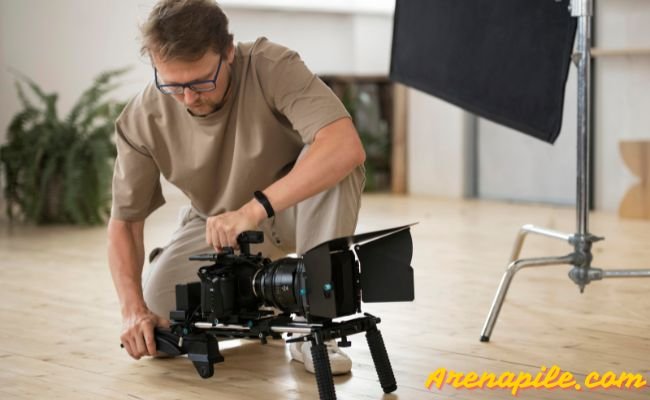Mastering Cinematography: 17 Essential Filmmaking Techniques for Cinematic Shots
Filmmaking is a complex and creative art form that blends storytelling with technical expertise. Understanding a range of Best filmmaking techniques for beginners is crucial for any aspiring filmmaker looking to create compelling and visually stunning movies. This article will delve into 17 essential filmmaking techniques, each contributing uniquely to the filmmaking process. Whether you’re a novice or a seasoned professional, mastering these techniques can enhance your storytelling and cinematic vision. Below is the list of film techniques Hope you enjoy it and learn from it.
Learn Filmmaking Techniques With Examples
1. Storyboarding
What is Storyboarding?
Storyboarding is a critical pre-production process where scenes are sketched out in sequence, much like a comic strip. This technique helps filmmakers visualize the narrative flow and plan the shots, angles, and transitions before actual filming begins.
Importance of Storyboarding
A well-crafted storyboard ensures that everyone involved in the production shares the same vision. For instance, in Alfred Hitchcock’s “Psycho,” detailed storyboards were crucial for the iconic shower scene, ensuring that each shot built suspense effectively.
Benefits of Storyboarding
By pre-visualizing the film, directors can communicate their ideas more clearly to the crew, saving time and resources on set. Storyboarding also allows for early detection of potential issues, enabling creative problem-solving before filming.
2. Camera Angles Techniques
Overview of Camera Angles
Camera angles are fundamental in influencing how the audience perceives the story and characters. High angles can make a subject appear small or vulnerable, while low angles can convey power and dominance.
Types of Camera Angles
Eye-level shots are neutral, often used to create a connection between the audience and the characters. For example, in “Citizen Kane,” Orson Welles used extreme low-angle shots to emphasize Charles Foster Kane’s imposing presence.

Impact Of Camera Angles And Basic Cinematography Techniques
Experimenting with different angles can provide fresh perspectives and add depth to the narrative. Understanding when and how to use these angles can significantly impact the emotional and visual tone of your film.
3. Shot Composition
Elements of Shot Composition
Shot composition involves arranging visual elements within the frame to create a balanced and aesthetically pleasing image. Techniques such as the rule of thirds, leading lines, and framing guide the viewer’s eye to important aspects of the scene.
Techniques for Effective Composition
For example, in Wes Anderson’s films, meticulous composition using symmetry and color coordination creates a distinctive, visually appealing style. Good composition enhances storytelling by emphasizing key elements and creating a harmonious visual flow.
Benefits of Mastering Composition
Learning to master shot composition will make your scenes more dynamic and engaging, helping to convey the story more effectively.
4. Lighting Techniques
Types of Lighting and depth of field considerations
Lighting is a powerful tool in filmmaking, used to set the mood, highlight characters, and create depth within a scene. Key lighting, acting as the primary light source, illuminates the subject, while fill lighting reduces shadows, and backlighting separates the subject from the background.
Natural vs. Artificial Lighting
Natural lighting provides a realistic feel, whereas artificial lighting can create dramatic effects. In “Blade Runner,” the use of neon lights and shadows crafted a futuristic, dystopian atmosphere.
Impact of Lighting
Mastering lighting techniques allows filmmakers to manipulate the scene’s mood and tone, enhancing the emotional impact of the story.
5. Cinematography techniques for better cinematic shots
Role of Cinematography
Cinematography is the art of capturing visual images on film or digital media. It encompasses techniques such as long takes, handheld shots, and the use of Steadicam.
Techniques in Cinematography
The cinematographer, or director of photography (DP), collaborates with the director to achieve the desired look and feel of the film. For instance, Emmanuel Lubezki’s work in “Birdman” is renowned for its seamless long takes, creating a continuous, immersive experience.
Benefits of Good Cinematography
Effective cinematography not only enhances the visual appeal of a film but also supports the narrative by guiding the audience’s emotions and focus.
6. Editing Techniques
Importance of Editing
Editing is the process of selecting and combining shots to create a coherent and compelling narrative. Techniques like cross-cutting, jump cuts, and montage help to shape the story’s pacing and structure.
Editing Techniques
In “Pulp Fiction,” Quentin Tarantino’s use of non-linear editing challenges traditional storytelling, creating a unique and engaging experience. Good editing maintains the flow of the story, ensuring that each scene transitions smoothly to the next.
Impact of Editing
Understanding editing techniques allows filmmakers to manipulate time, build tension, and enhance the overall storytelling.
7. Sound Design
Elements of Sound Design
Sound design involves creating the auditory elements of a film, including dialogue, sound effects, and ambient sound. Effective sound design immerses the audience in the film’s world, making the story more believable.
Techniques in Sound Design and tips for beginner filmmakers
For example, in “Jurassic Park,” the sound of the dinosaurs, crafted from various animal noises, adds to the film’s realism and excitement. Sound design also includes the use of silence and background noise to build tension and atmosphere.
Benefits of Good Sound Design
Mastering sound design techniques ensures that the audio complements the visual elements, enhancing the overall cinematic experience.
8. Music Score
Role of Music in Filmmaking
A film’s music score plays a crucial role in setting the emotional tone and enhancing the narrative. Music can underscore dramatic moments, build tension, or provide relief.
Techniques for Integrating Music
John Williams’ score for “Star Wars” is iconic, with its memorable themes that evoke adventure and heroism. Integrating music effectively involves understanding how it interacts with the visual elements and the story, a technique that heightens emotional impact.
Impact of Music Scores
A well-composed score can elevate the film, making scenes more impactful and memorable. Choosing the right music and knowing when to use it can significantly enhance the emotional resonance of your film.
9. Special Effects
Types of Special Effects
Special effects (SFX) are techniques used to create illusions or visual tricks that are impossible or impractical to achieve in real life. Practical effects, like puppetry and makeup, are combined with digital effects to enhance realism.
Examples of Special Effects
The groundbreaking effects in “Jurassic Park” blended animatronics with CGI to create lifelike dinosaurs. Special effects should support the story without overshadowing it.
Benefits of Mastering Special Effects
Mastering both practical and digital effects allows filmmakers to push the boundaries of their imagination, creating fantastical worlds and extraordinary scenes that captivate audiences.
10. Production Design
Elements Of Production Design And Composition Techniques
Production design encompasses the visual elements that create the world of the film, including sets, props, and costumes. A cohesive production design supports the story by creating a believable environment.
Techniques in Production Design
In “The Grand Budapest Hotel,” the detailed and whimsical sets contribute significantly to the film’s charm and narrative. Good production design requires attention to detail and a clear vision of the film’s aesthetic.
Impact Of Production Design And Light Source Management
It helps to establish the time period, location, and mood, enhancing the story’s believability and immersion. Understanding production design techniques can significantly enrich the visual storytelling of your film.
11. Directing Film Techniques – Best Filmmaking Techniques For Directors
Role of the Director
Directing involves overseeing the creative aspects of a film, guiding the cast and crew to bring the script to life. A director must communicate their vision clearly and inspire the team to achieve it.
Techniques for Effective Directing
Techniques for working with actors, such as providing clear direction and constructive feedback, are essential. Directors like Steven Spielberg are known for their ability to elicit powerful performances and create engaging narratives.
Benefits of Mastering Directing
Effective directing requires a balance of creativity, leadership, and collaboration. Mastering directing techniques and basic cinematography ensures that the film’s artistic and technical elements come together cohesively.
12. Acting Techniques
Types of Acting Techniques
Acting techniques vary widely, from method acting, where actors immerse themselves in their characters, to classical acting, which focuses on external performance. Improvisation allows actors to create spontaneous and natural dialogue.
Examples of Great Acting
Great performances, like Daniel Day-Lewis in “There Will Be Blood,” often involve a deep understanding of the character’s motivations and emotions. Collaborating closely with the director and other actors is crucial for delivering a convincing performance.
Importance of Acting In Filmmaking TechniquesBenefits Of Understanding Acting Techniques
Understanding different acting techniques can help directors guide actors more effectively and create more nuanced and authentic performances.
13. Visual Effects (VFX)
Overview of VFX
Visual effects (VFX) involve creating imagery outside the realm of live-action filming, often using computer-generated imagery (CGI). Techniques such as green screen and motion capture are commonly used in VFX.
Examples of VFX in Film
Films like “Avatar” showcase the extensive use of CGI to create entirely new worlds and characters. Integrating VFX seamlessly with live-action footage is essential to maintain the film’s realism.
Benefits of Mastering VFX
Keeping up with trends and advancements in VFX technology can enhance the visual storytelling of your film, making it more immersive and visually stunning.
14. Color Grading
What Is Color Grading And How Does It Enhance Depth Of Field?
Color grading involves adjusting the colors of a film to create a specific look or mood. This post-production process enhances the visual tone and consistency of the film.
Techniques in Color Grading
For instance, the desaturated colors in “Mad Max: Fury Road” enhance its gritty, post-apocalyptic feel. Color grading can highlight particular emotions, set the atmosphere, and draw attention to key elements within the frame.
Benefits of Effective Color Grading
Mastering color grading techniques allows filmmakers to enhance the visual storytelling, creating a more engaging and emotionally resonant experience for the audience.
15. Mise-en-Scène
Definition of Mise-en-Scène
Mise-en-scène refers to the arrangement of everything that appears in the frame, including sets, props, actors, and lighting. It plays a crucial role in conveying the film’s themes and emotions.
Elements of Mise-en-Scène
For example, the cluttered, chaotic mise-en-scène in “Brazil” reflects the film’s dystopian world. Each element within the frame should serve the story, contributing to the overall mood and message.
Benefits of Mastering Mise-en-Scène
Understanding and effectively using mise-en-scène, a fundamental camera technique, allows filmmakers to craft visually rich and meaningful scenes, enhancing the depth and complexity of their storytelling.
16. Continuity
What is Continuity?
Continuity ensures that the visual and narrative elements of a film remain consistent throughout, maintaining the audience’s suspension of disbelief. This involves careful attention to details such as props, costumes, and lighting across different shots and scenes.
Common Continuity Errors Within The Scene
Common continuity errors, like changing props or mismatched clothing, can distract viewers. Techniques for ensuring continuity include detailed script supervision and meticulous planning.
Impact of Good Continuity
Maintaining continuity is essential for creating a seamless and immersive viewing experience, allowing the audience to stay engaged with the story.
17. Blocking
Definition of Blocking
Blocking refers to the precise staging of actors and cameras to ensure that movements are fluid and meaningful within a scene. Effective blocking enhances the narrative by directing the audience’s focus and revealing character dynamics.
Techniques in Blocking
In “La La Land,” the intricate dance sequences are a result of meticulous blocking that blends choreography with storytelling. Good blocking involves collaboration between the director, cinematographer, and actors.
Benefits of Effective Blocking
Mastering blocking techniques can significantly enhance the visual and emotional impact of your film, making scenes more dynamic and engaging.
FAQ’s About Filmmaking Techniques In Cinematography
Q: What is cinematography?
A: Cinematography refers to the art and science of capturing moving images on film or a digital medium. It involves choosing the right camera angles, lighting, and camera movements to create visually stunning shots.
Q: What are some common filmmaking techniques used in cinematography?
A: Some common filmmaking techniques include close-ups, tilts, pans, zooms, and tracking shots. These techniques are used to enhance the visual storytelling in a film.
Q: What is an establishing shot?
A: An establishing shot is a wide-angle shot at the beginning of a scene or sequence that sets up the location and context for the audience. It helps viewers understand where the action is taking place.
Q: How can cinematography be used to tell a story?
A: Cinematography plays a crucial role in storytelling by using visual elements such as camera angles, lighting, and framing to evoke emotions, create atmosphere, and convey the narrative effectively.
Q: What are advanced filmmaking techniques that can enhance my cinematography skills?
A: Advanced filmmaking techniques such as the dolly shot, dutch angle shot, and steadicam can add depth and creativity to your cinematography work. These techniques require skill and practice but can elevate your shots to a professional level.
Q: How can I improve my camera movements in cinematography?
A: To enhance your camera movements, you can experiment with techniques like dollying, panning, tracking, and zooming. Each movement adds a different dynamic to your shots and helps create visually engaging sequences.
Q: What is the importance of lighting design in cinematography?
A: Lighting design is crucial in cinematography as it sets the mood, emphasizes important elements, and creates depth in the scene. By understanding how to manipulate light, cinematographers can enhance the visual storytelling in their films.
Conclusion
Mastering these 17 filmmaking techniques is essential for any filmmaker aiming to create compelling, visually stunning, and emotionally resonant films. Each technique plays a unique role in the filmmaking process, from pre-production planning with storyboarding to post-production enhancements like color grading. By understanding and applying these filmmaking techniques, you can elevate your storytelling, create memorable cinematic experiences, and develop your unique style. Keep experimenting, learning, and refining your craft to become a master filmmaker.




